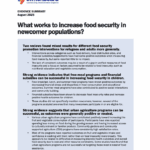Inadequate access to food is a risk factor for poor health and the effectiveness of federal programs targeting food insecurity, such as the Supplemental Nutrition Assistance Program (SNAP), are well-documented. The associations between other types of interventions to provide adequate food access and food insecurity status, health outcomes, and health care utilization, however, are unclear.To review evidence on the association between food insecurity interventions and food insecurity status, clinically-relevant health outcomes, and health care utilization among adults, excluding SNAP.A systematic search for English-language literature was performed in PubMed Central and Cochrane Trials databases (inception to January 23, 2020), the Social Interventions Research and Evaluation Network database (December 10, 2019); and the gray literature using Google (February 1, 2021).Studies of any design that assessed the association between food insecurity interventions for adult participants and food insecurity status, health outcomes, and health care utilization were screened for inclusion. Studies of interventions that described addressing participants’ food needs or reporting food insecurity as an outcome were included. Interventions were categorized as home-delivered food, food offered at a secondary site, monetary assistance in the form of subsidies or income supplements, food desert interventions, and miscellaneous.Data extraction was performed independently by 3 reviewers. Study quality was assessed using the Cochrane Risk of Bias Tool, the ROBINS-I (Risk of Bias in Non-Randomized Studies of Interventions) tool, and a modified version of the National Institutes of Health’s Quality Assessment Tool for Before-After Studies With No Control. The certainty of evidence was based on GRADE (Grading of Recommendations Assessment, Development, and Evaluation) criteria and supplemented with mechanistic and parallel evidence. For outcomes within intervention categories with at least 3 studies, random effects meta-analysis was performed.Food insecurity (measured through surveys; eg, the 2-item Hunger Vital Sign), health outcomes (eg, hemoglobin A1c), and health care utilization (eg, hospitalizations, costs).A total of 39 studies comprising 170 605 participants were included (8 randomized clinical trials and 31 observational studies). Of these, 14 studies provided high-certainty evidence of an association between offering food and reduced food insecurity (pooled random effects; adjusted odds ratio, 0.53; 95% CI, 0.33-0.67). Ten studies provided moderate-certainty evidence of an association between offering monetary assistance and reduced food insecurity (pooled random effects; adjusted odds ratio, 0.64; 95% CI, 0.49-0.84). There were fewer studies of the associations between interventions and health outcomes or health care utilization, and the evidence in these areas was of low or very low certainty that any food insecurity interventions were associated with changes in either.This systematic review with meta-analysis found that providing food and monetary assistance was associated with improved food insecurity measures; however, whether it translated to better health outcomes or reduced health care utilization was unclear.
The management of volunteers – What can human resources do? A review and research agenda
There is an increasing interest from scholars and practitioners in understanding how non-profit organizations can design and implement human resources (HR) practices to enhance desirable volunteer attitudes and behaviors. This paper presents a comprehensive overview of existing studies on the relationship between HR practices and volunteering outcomes. We use the ability-motivation-opportunity model as a guiding…

